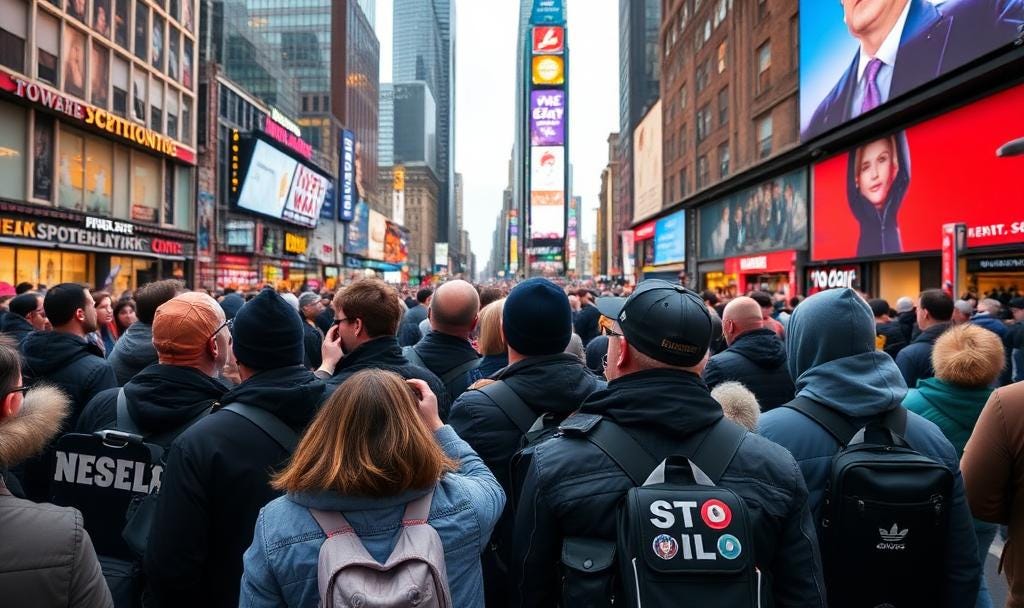Frequency of Observation
Density drives perception
Here’s a thought experiment. Let’s commit a really obvious crime like assault in the middle of Times Square.
I’m talking mind-shatteringly obvious here. Two big loud guys, screaming incomprehensibly at each other, in the middle of a beautiful Saturday afternoon. The kind of assault that makes you think, “Hey, that guy is really getting assaulted.”
Tourists are staring aghast. Phones are coming out left and right, triplexes of lenses fixed on the nightmare. Regular New Yorkers actually care to look.
You might have thousands of direct witnesses to the crime. Then all of their networks hear about it or see it on their feeds. Maybe it goes viral on a local subreddit or in right-wing Twitter circles. So one incident could reach millions of people in some form.
Now imagine that same altercation in North Dakota. Anywhere in North Dakota really, even the busiest street corner on NDSU game day (go Bisons!). You could crack into the low hundreds. Local news might pick it up and get you into the thousands or even tens of thousands. Some social media pickup too, maybe hit 100k.
And that’s an upper bound! Way more things happen in public in big cities than in small cities, let alone suburbs or the country. If the same assault happens in a lonely McDonald’s or in a single family home, almost nobody is going to see it.
So one crime in two different environments is going to produce observation counts different by potentially orders of magnitude.
And frequency of observation isn’t going to be linear with frequency of occurrence. If the assault rate in North Dakota and in New York City is similar, but the observation rate is 100x in NYC because of the density, the perception of crime is going to be much higher in NYC. Even if the assault rate in North Dakota is 10x the assault rate in NYC, the frequency of observation is still going to swamp the frequency of occurrence.
This unintuitive asymmetry between frequency of occurrence and frequency of observation isn’t new. It’s a property of a lot of systems and networks.
Consider social networks. Most people have a small number of friends, and a small number of people have a lot of friends. So these superconnectors are objectively rare, yet because superconnectors by definition have many friends, most people are friends with at least one superconnector! So subjectively they are not rare. The frequency of observation is much higher than the frequency of occurrence.
It’s not a new finding, but it’s unintuitive. And I think it resolves the tension between “crime seems rampant in [city]” and “actually crime is low in [city]”. They’re both right, biases aside; observation of crime can be high even when occurrence of crime is low.
In the age of social media, we can combine our density story with our social network finding. Let’s say only 1% of social media users have a significant following. If fewer than 100 people witness and post about a crime, then in many cases none of them will have a significant following. So many smaller events will never make it out into the wider internet world, further increasing the outsize perception of crime in cities.1
None of this minimizes the impact of crime and any dangerous increases in crime rates. It only addresses the mismatch between actual crime rates and perceptions of crime rates.
Do certain media outlets amplify big city crime? Yes. Does it serve certain political figures to harp on it? Of course. But the perception of high crime is not only due to the usual suspects. The objective frequency of observation acts too, right alongside the subjective salience these outlets and figures award it.
We’re not even taking into account the mismatch in interest between North Dakota and NYC. The audience and the algorithmic attraction are both going to be in NYC’s “favor” here



This post rhymes very well with https://ringohosp.substack.com/p/guests-usually-see-us-at-an-unusual !